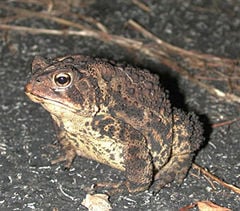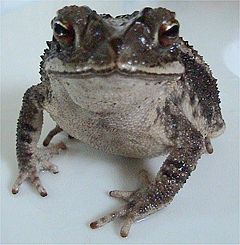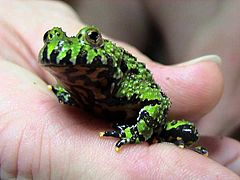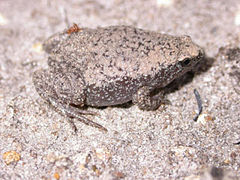Toad
| Toads | ||||||||
|---|---|---|---|---|---|---|---|---|
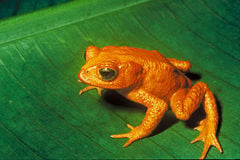 Golden Toad, Bufo periglenes
| ||||||||
| Scientific classification | ||||||||
| ||||||||
|
At least 9, see article. |
Broadly defined, toad is the common term applied to largely terrestrial members of the amphibian order Anura, whose frog-like body generally is characterized by short legs, a stocky body, and a drier, rougher skin than frogs. This division of anurans into toads and frogs is a popular, not a scientific distinction; it does not represent a formal taxonomic rank. More narrowly defined, the "true toads" are those anurans that belong to the taxonomic family Bufonidae.
Overview
Frogs and toads belong to the order Anura ("without a tail") or Salientia. About five thousand species of anurans have been identified, and these are classified into about 30 families. Frogs and toads differ from the other amphibian orders by the presence of larger hind limbs among the four limbs. Extant adult anurans lack tails. Frogs and toads are the most numerous and diverse amphibians, being found in nearly all habitats, including aboral, aquatic and terrestrial niches, and every continent except Antarctica. Three species have ranges that extend above the Arctic Circle. The terms frog and toad are imprecise, with "toad" commonly being used for any species that is adapted to a dry environment. Anurans have well developed voices, whereas the other two orders of amphibians are limited to sounds such as coughs and grunts.
A distinction is often made between frogs and toads on the basis of their appearance, caused by the convergent adaptation among so-called toads to dry environments; however, this distinction has no taxonomic basis. The only family exclusively given the common name "toad" is Bufonidae, but many species from other families are also called "toads," and the species within the toad genus Atelopus are referred to as "harlequin frogs."
The use of the common names "frog" and "toad" has no taxonomic justification. From a taxonomic perspective, all members of the order Anura are frogs, but only members of the family Bufonidae are considered "true toads". The use of the term "frog" in common names usually refers to species that are aquatic or semi-aquatic with smooth and/or moist skins, and the term "toad" generally refers to species that tend to be terrestrial with dry, warty skin. An exception is the Fire-bellied toad (Bombina bombina): while its skin is slightly warty, it prefers a watery habitat.
refers to a number of species of amphibians. A distinction is often made between frogs and toads by their appearance, prompted by the convergent adaptation among so-called toads to dry environments, which often entails a brown skin for camouflage which is also dry and leathery for better water retention. Many so-called toads also burrow, which requires further adaptations. However, these adaptations merely reflect the environment a species has adapted to, and are not reliable indicators of its ancestry. Since taxonomy reflects only evolutionary relationships, any distinction between frogs and toads is irrelevant to their classification.
For instance, many members of the families Bombinatoridae, Discoglossidae, Pelobatidae, Rhinophrynidae, Scaphiopodidae, and some species from the Microhylidae family are commonly called "toads". However, the only family exclusively given the common name "toad" is Bufonidae, the "true toads". Some "true frogs" of the genus Rana, have also adapted to burrowing habits, while the species within the toad genus Atelopus are conversely known by the common name "harlequin frogs".
The type species of the family Bufonidae is the Common Toad, Bufo bufo, and around it cluster a large number of species of the same genus and some smaller genera. B. bufo is a tailless amphibian of stout build with a warty skin and any animal that shares these characteristics is liable to be called a toad, regardless of its location in formal taxonomy.
Almost all toads of the family Bufonidae have two lumps on either side of the back of their head, called the parotoid glands. These glands contain a poison, which oozes out if the toad is stressed. Some, like the Cane Toad Bufo marinus, are more toxic than others. Some "psychoactive toads" such as the Colorado River Toad Bufo alvaris, have been used recreationally for the effects of the bufotoxin, by either their skin secretions or eating boiled toads.
Taxonomy
True toads
Family Bufonidae (Gray, 1825) - True Toads:
- Adenomus (Cope, 1861)
- Altiphrynoides (Dubois, 1987)
- Andinophryne (Hoogmoed, 1985)
- Ansonia (Stoliczka, 1870)
- Atelophryniscus (McCranie, Wilson & Williams, 1989)
- Atelopus (Duméril & Bibron, 1841)
- Bufo (Laurenti, 1768)
- Bufoides (Pillai & Yazdani, 1973)
- Capensibufo (Grandison, 1980)
- Churamiti (Channing & Stanley, 2002)
- Crepidophryne (Cope, 1889)
- Dendrophryniscus (Jiménez de la Espada, 1871)
- Didynamipus (Andersson, 1903)
- Frostius (Cannatella, 1986)
- Laurenhryne (Tihen, 1960)
- Leptophryne (Fitzinger, 1843)
- Melanophryniscus (Gallardo, 1961)
- Mertensophryne (Tihen, 1960)
- Metaphryniscus (Señaris, Ayarzagüena & Gorzula, 1994)
- Nectophryne (Buchholz & Peters, 1875)
- Nectophrynoides (Noble, 1926)
- Nimbaphrynoides (Dubois, 1987)
- Oreophrynella (Boulenger, 1895)
- Osornophryne (Ruiz-Carranza & Hernández-Camacho, 1976)
- Parapelophryne (Fei, Ye & Jiang, 2003)
- Pedostibes (Günther, 1876)
- Pelophryne (Barbour, 1938)
- Pseudobufo (Tschudi, 1838)
- Rhamphophryne (Trueb, 1971)
- Schismaderma (Smith, 1849)
- Spinophrynoides (Dubois, 1987)
- Stephopaedes (Channing, 1979)
- Truebella (Graybeal & Cannatella, 1995)
- Werneria (Poche, 1903)
- Wolterstorffina (Mertens, 1939)
Other toad families
Family Bombinatoridae (Gray, 1825) - Fire-bellied Toads:
- Barbourula (Taylor & Noble, 1924)
- Bombina (Oken, 1816)
Family Brachyctpoephalidae (Günther, 1858) - Shield Toads:
- Brachycephalus (Fitzinger, 1826)
Family Discoglossidae (Günther, 1858)
- Alytes (Wagler, 1830) - Midwife Toad
Family Microhylidae (Günther, 1858)
- Subfamily Microhylinae - Narrowmouthed Toads:
- Gastrophryne (Fitzinger, 1843)
Family Pelobatidae (Bonaparte, 1850) - European Spadefoot Toads:
- Pelobates (Wagler, 1830)
Family Scaphiopodidae (Cope, 1865) - North American Spadefoot Toads:
- Scaphiopus (Holbrook, 1836)
- Spea (Cope, 1866)
Family Rhinophrynidae (Günther, 1859) - Burrowing Toads:
- Rhinophrynus (Duméril and Bibron, 1841)
ReferencesISBN links support NWE through referral fees
- Anura (TSN 173423). Integrated Taxonomic Information System. Accessed on 4 May 2006.
See also
List of frogs and toads by state (U.S.)
External links
Credits
New World Encyclopedia writers and editors rewrote and completed the Wikipedia article in accordance with New World Encyclopedia standards. This article abides by terms of the Creative Commons CC-by-sa 3.0 License (CC-by-sa), which may be used and disseminated with proper attribution. Credit is due under the terms of this license that can reference both the New World Encyclopedia contributors and the selfless volunteer contributors of the Wikimedia Foundation. To cite this article click here for a list of acceptable citing formats.The history of earlier contributions by wikipedians is accessible to researchers here:
The history of this article since it was imported to New World Encyclopedia:
Note: Some restrictions may apply to use of individual images which are separately licensed.
